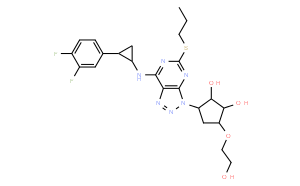
 COA COA |
 MSDS MSDS |
 HPLC HPLC |
 NMR NMR |
| CAS No: | 274693-27-5 |
| Molecular formula(MF) | C23H28F2N6O4S |
| Molecular Weight(MW): | 522.57 |
| Alias | (1S,2S,3R,5S)-3-[7-[[(1R,2S)-2-(3,4-Difluorophenyl)cyclopropyl]amino]-5-(propylthio)-3H-1,2,3-triazolo[4,5-d]pyrimidin-3-yl]-5-(2-hydroxyethoxy)-1,2-cyclopentanediol |
| In vitro | DMSO | 105 mg/mL (200.93 mM) |
|---|---|---|
| Ethanol | 53 mg/mL (101.42 mM) | |
| Water | <1 mg/mL |
| Description | Ticagrelor is the first reversibly binding oral P2Y12 receptor antagonist with Ki of 2 nM. | ||||||
|---|---|---|---|---|---|---|---|
| Features | First-in-class of a new type of P2Y12 antagonist known as cyclopentyl-triazolo-pyrimidines. | ||||||
| Targets |
|
||||||
| In vitro |
Ticagrelor is an active drug which, does not require metabolic activation after intestinal absorption. It does not compete directly with ADP at the ADP binding site but occupies an adjacent binding site and acts in an allosteric way, resulting in a reversible conformational change of the receptor. Ticagrelor binds reversibly to the receptor and exhibits rapid onset and offset of effect. Binding studies in rh-P2Y12 receptor-transfected CHO-K1 cells indicate that ticagrelor exhibits potent, rapid, and reversible binding, with a Kd of 10.5 nM, a kon (association constant) of 0.00011/(nM•s), a koff (dissociation constant) of 0.00087/s, and half-life values of 4 min for binding and 14 min for unbinding, indicating that the magnitude of platelet inhibition is dependent on concentrations of drug available to bind platelets. [1] Ticagrelor moderately inhibits CYP2C9 activity in human liver microsomes, while exhibiting little or no inhibition of CYP1A2, CYP2B6, CYP2C8, CYP2C19, CYP2D6, and CYP2E1. In human liver microsomes, ticagrelor inhibits midazolam 4-hydroxylation, while activating 1_-hydroxylation of midazolam. Evaluated in fresh human hepatocytes, ticagrelor is not an inducer of CYP1A2 or CYP3A4. [3] |
||||||
| In vivo | Absorption of ticagrelor is rapid with t max of 1.3-2 h. And the Cmax and area under the plasma concentration-time curve from time 0 to infinity increases in an apparently dose-proportional manner over the dose range studied, indicating linear pharmacokinetics. The mean terminal-phase half-life (t1/2) is approximately 7-8.5 h for ticagrelor. Inhibition of platelet aggregation (IPA) is dose related and is nearly complete at 2 h at doses of 100-400 mg. Ticagrelor is well tolerated, with no serious or doserelated adverse events or notable changes in laboratory values observed. [2] |